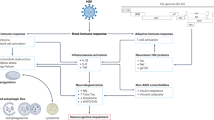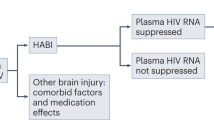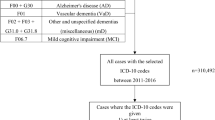Abstract
In the US, HIV dementia occurs in 10–15% of HIV-positive individuals with advanced infection. The prevalence of HIV dementia in sub-Saharan countries, where the vast majority of individuals with HIV reside, is largely unknown. This Review will summarize our current understanding of HIV-associated cognitive impairment in resource-limited settings, focusing specifically on the countries of sub-Saharan Africa. We will describe the frequency of HIV dementia and HIV-associated cognitive impairment from several case series in the sub-Saharan region. We will then summarize recent studies from Uganda and Ethiopia that included detailed neuropsychological assessments. The potential influence of clade diversity on HIV-associated cognitive impairment will be discussed. Differences between the results of the studies in Uganda and in Ethiopia raise the possibility that HIV subtypes might have different biological properties with respect to their capacity to cause HIV-associated cognitive impairment. Further studies are needed to determine the true prevalence of HIV dementia in sub-Saharan Africa and to establish whether specific clade subtypes might influence the presentation of neurological complications.
Key Points
-
HIV dementia is characterized by cognitive, behavioral and motor dysfunction
-
HIV-1 subtypes in the US and Europe differ from subtypes seen elsewhere in the world
-
The frequency of HIV dementia in sub-Saharan Africa is largely unknown, but one study in Uganda suggests that 31% of HIV-positive individuals with advanced infection could have dementia
-
Differences in HIV-1 subtype could cause differences in HIV-associated neurological disease
-
HIV dementia might be among the most common forms of dementia worldwide, along with Alzheimer's disease and vascular dementia
This is a preview of subscription content, access via your institution
Access options
Subscribe to this journal
Receive 12 print issues and online access
$209.00 per year
only $17.42 per issue
Buy this article
- Purchase on Springer Link
- Instant access to full article PDF
Prices may be subject to local taxes which are calculated during checkout

Similar content being viewed by others
References
Joint United Nations Program on HIV/AIDS.UN/AIDS and The World Health Organization. AIDS Epidemic Update, Dec 2003
Sacktor N (2002) The epidemiology of human immunodeficiency virus-associated neurological disease in the era of highly active antiretroviral therapy. J Neurovirol 8 (Suppl 2): S115–S121
Birbeck GL (2005) Human immunodeficiency virus dementia patients in Africa: How many? Who cares? And where to from here? J Neurovirol 11 (Suppl 3): S30–S33
Sacktor NC et al. (2005) The International HIV Dementia Scale: a new rapid screening test for HIV dementia. AIDS 19: 1367–1374
Spira S et al. (2003) Impact of clade diversity on HIV-1 virulence, antiretroviral drug sensitivity and drug resistance. J Antimicrob Chemother 51: 229–240
Simon F et al. (1998) Identification of a new human immunodeficiency virus type 1 distinct from group M and group O. Nat Med 4: 1032–1037
Renjifo B and Essex M (2002) HIV-1 subtypes and recombinants. In AIDS in Africa, 138–157 (Eds Essex M et al.) New York: Kluwer Academic/Plenum Publishers
Quinones-Mateu ME and Arts EJ (1999) Recombination in HIV-1: update and implications. AIDS Rev 1: 89–100
Triques K et al. (2000) Near-full-length genome sequencing of divergent African HIV type 1 subtype F viruses leads to the identification of a new HIV type 1 subtype designated K. AIDS Res Hum Retroviruses 16: 139–151
Piot P and Bartos M (2002) The epidemiology of HIV and AIDS. In AIDS in Africa, 200–217 (Eds Essex M et al.) New York: Kluwer Academic/Plenum Publishers
Janssens W et al. (1997) The puzzle of HIV-1 subtypes in Africa. AIDS 11: 705–712
Coffin JM et al. 1997) Retroviruses. New Jersey: Cold Spring Laboratory Press
Sacktor N et al. (2006) Antiretroviral therapy improves cognitive impairment in HIV+ individuals in sub-Saharan Africa. Neurology 67: 311–314
Laeyendecker O et al. (2006) The effect of HIV subtype on rapid disease progression in Rakai, Uganda [abstract #44LB]. Presented at the 13th Conference on Retroviruses and Opportunistic Infections: 2006 February 5–8, Denver, CO
Vasan A et al. (2006) Different rates of disease progression of HIV type 1 infection in Tanzania based on infecting subtype. Clin Infect Dis 42: 843–852
Maj M et al. (1994) WHO Neuropsychiatric AIDS study, cross-sectional phase II: neuropsychological and neurological findings. Arch Gen Psychiatry 51: 51–61
Howlett WP et al. (1989) Neurological disorders in AIDS and HIV disease in the northern zone of Tanzania. AIDS 3: 289–296
Perriens JH et al. (1992) Neurological complications of HIV-1-seropositive internal medicine inpatients in Kinshasa, Zaire. J Acquir Immune Defic Syndr 5: 333–340
Pierotti C et al. (2002) A prospective study on neuro-AIDS with emphasis on cerebrospinal fluid analysis in an Ugandan rural hospital. J Neurovirol 8 (Suppl): SP224
Wong M et al. (2007) Frequency of and risk factors for HIV dementia in an HIV clinic in sub-Saharan Africa. Neurology 68: 350–355
Wechsler D (1981) Wechsler Adult Intelligence Scale Revised. New York: The Psychological Corporation
Selnes OA et al. (1991) Normative data for a brief neuropsychological screening battery. Percept Mot Skills 73: 539–550
Lawton MP and Brody EM (1969) Assessment of older people: self-maintaining and instrumental activities of daily living. Gerontologist 9: 179–186
Katz S et al. (1963) Studies of illness in the aged: the index of ADL. JAMA 183: 914–919
Karnofsky DA et al. (1948) The use of nitrogen mustards in the palliative treatment of carcinoma. Cancer 1: 634–656
Clifford D et al. (2007) Neurological evaluation of untreated human immunodeficiency virus infected adults in Ethiopia. J Neurovirol 13: 67–72
Clifford DB et al. (2005) Impact of efavirenz on neuropsychological performance and symptoms in HIV-infected individuals. Ann Intern Med 143: 714–721
Schmitt FA et al. (1988) Neuropsychological outcome of zidovudine (AZT) treatment of patients with AIDS and AIDS-related complex. N Engl J Med 319: 1573–1578
Ball SC et al. (2003) Comparing the ex vivo fitness of CCR5-tropic human immunodeficiency virus type 1 isolates of subtypes B and C. J Virol 77: 1021–1038
Acknowledgements
The authors thank Alice Namudde and Fred Sebuuma for their work as research assistants for the Ugandan studies, and Marie Sonderman for providing administrative support.
Author information
Authors and Affiliations
Corresponding author
Ethics declarations
Competing interests
The authors declare no competing financial interests.
Rights and permissions
About this article
Cite this article
Sacktor, N., Nakasujja, N., Robertson, K. et al. HIV-associated cognitive impairment in sub-Saharan Africa—the potential effect of clade diversity. Nat Rev Neurol 3, 436–443 (2007). https://doi.org/10.1038/ncpneuro0559
Received:
Accepted:
Issue Date:
DOI: https://doi.org/10.1038/ncpneuro0559
This article is cited by
-
Mechanisms underlying HIV-associated cognitive impairment and emerging therapies for its management
Nature Reviews Neurology (2023)
-
Effect of coinfections on neurocognitive functioning among people with clade C HIV infection in Zambia
Journal of NeuroVirology (2023)
-
Child maltreatment, cognitive functions and the mediating role of mental health problems among maltreated children and adolescents in Uganda
Child and Adolescent Psychiatry and Mental Health (2021)
-
Use of Western Neuropsychological Test Battery in Detecting HIV-Associated Neurocognitive Disorders (HAND) in Zambia
AIDS and Behavior (2017)
-
Proceedings from the NIMH symposium on “NeuroAIDS in Africa: neurological and neuropsychiatric complications of HIV”
Journal of NeuroVirology (2016)



